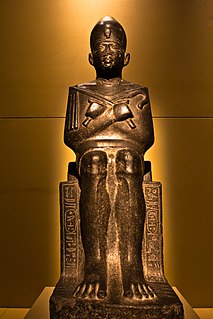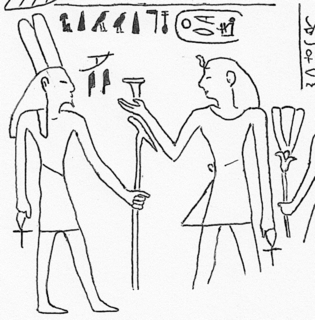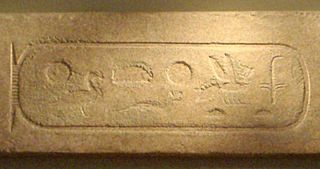Related Research Articles

Pharaoh is the common title now used for the monarchs of ancient Egypt from the First Dynasty until the annexation of Egypt by the Roman Empire in 30 BCE, although the term "pharaoh" was not used contemporaneously for a ruler until Merneptah, c. 1210 BCE, during the Nineteenth dynasty, "king" being the term used most frequently until the middle of the Eighteenth Dynasty. In the early dynasties, ancient Egyptian kings used to have up to three titles: the Horus, the Sedge and Bee, and the Two Ladies or Nebty name. The Golden Horus as well as the nomen and prenomen titles were added later.

Merneferre Ay was an ancient Egyptian pharaoh of the mid 13th Dynasty. The longest reigning pharaoh of the 13th Dynasty, he ruled a likely fragmented Egypt for over 23 years in the early to mid 17th century BC. A pyramidion bearing his name shows that he possibly completed a pyramid, probably located in the necropolis of Memphis.

Menpehtyre Ramesses I was the founding pharaoh of ancient Egypt's 19th Dynasty. The dates for his short reign are not completely known but the time-line of late 1292–1290 BC is frequently cited as well as 1295–1294 BC. While Ramesses I was the founder of the 19th Dynasty, his brief reign mainly serves to mark the transition between the reign of Horemheb, who had stabilized Egypt in the late 18th Dynasty, and the rule of the powerful pharaohs of his own dynasty, in particular his son Seti I, and grandson Ramesses II.

Senakhtenre Ahmose, or Ahmose "the Elder" was the seventh king of the Seventeenth Dynasty of Egypt during the Second Intermediate Period. Senakhtenre reigned for a short period over the Theban region in Upper Egypt at a time where the Hyksos 15th Dynasty ruled Lower Egypt. Senakhtenre died c.1560 or 1558 BC at the latest.
The royal titulary or royal protocol is the standard naming convention taken by the pharaohs of ancient Egypt. It symbolises worldly power and holy might and also acts as a sort of mission statement for the reign of a monarch.

Smenkhkare Imyremeshaw was an Egyptian pharaoh of the mid 13th Dynasty during the Second Intermediate Period. Imyremeshaw reigned from Memphis, starting in 1759 BC or 1711 BC. The length of his reign is not known for certain; he may have reigned for five years and certainly less than ten years. Imyremeshaw is attested by two colossal statues now in the Egyptian Museum, Cairo.

Sehetepkare Intef was the twenty-third king of the 13th Dynasty during the Second intermediate period. Sehetepkare Intef reigned from Memphis for a short period, certainly less than ten years, between 1759 BC and 1749 BC or c. 1710 BC.

Merhotepre Sobekhotep was an Egyptian king of the 13th Dynasty during the Second Intermediate Period. According to egyptologist Kim Ryholt he was the thirtieth pharaoh of the dynasty, while Darrell Baker believes instead that he was its twenty-ninth ruler. In older studies, Jürgen von Beckerath and Detlef Franke identified Merhotepre Sobekhotep with Merhotepre Ini, thereby making him Sobekhotep VI and the twenty-eighth ruler of the 13th Dynasty.

Sekhemre-Heruhirmaat Intef was an ancient Egyptian king of the Seventeenth Dynasty of Egypt, who ruled during the Second Intermediate Period, when Egypt was divided between the Theban-based 17th Dynasty in Upper Egypt and the Hyksos 15th Dynasty who controlled Lower and part of Middle Egypt.
Nepherites II or Nefaarud II was the last pharaoh of the feeble and short-lived Twenty-ninth Dynasty, the penultimate native dynasty of Egypt.

Rudamun was the final pharaoh of the Twenty-third Dynasty of Egypt. His titulary simply reads as Usermaatre Setepenamun, Rudamun Meryamun, and excludes the Si-Ese or Netjer-Heqawaset epithets employed by his father and brother.

Ameny Qemau was an Egyptian pharaoh of the 13th Dynasty during the Second Intermediate Period. According to Egyptologists Kim Ryholt and Darrell Baker, he was the 5th king of the dynasty, reigning for 2 years over most of Egypt, except perhaps the eastern Nile Delta, from 1793 BC until 1791 BC.

Seuserenre Bebiankh was a native ancient Egyptian king of the 16th Theban Dynasty during the Second Intermediate Period and, according to Kim Ryholt, the successor of king Semenre. He is assigned a reign of 12 years in the Turin Canon (11.8).
Bebiankh was succeeded either by a poorly known king named Sekhemre Shedwast or by the equally shadowy ruler Seneferankhre Pepi III.

Seankhibre Ameny Antef Amenemhet VI was an Egyptian pharaoh of the early Thirteenth Dynasty ruling in the first half of the 18th century BC during a time referred to as the late Middle Kingdom or early Second Intermediate Period, depending on the scholar. Amenemhat VI certainly enjoyed a short reign, estimated at 3 years or shorter. He is attested by a few contemporary artefacts and is listed on two different king lists. He may belong to a larger family of pharaohs including Amenemhat V, Ameny Qemau, Hotepibre Qemau Siharnedjheritef and Iufni.

Merdjefare was an ancient Egyptian pharaoh of the 14th Dynasty of Egypt during the Second Intermediate Period c. 1700 BC. As a king of the 14th Dynasty, Merdjefare would have reigned from Avaris over the eastern Nile Delta and possibly over the western Delta as well.

Sekhemrekhutawy Khabaw was an Egyptian pharaoh of the early 13th Dynasty during the Second Intermediate Period.

Djedkheperew was an Egyptian pharaoh of the 13th Dynasty reigning for an estimated two-year period, from c. 1772 BC until 1770 BC. According to Egyptologists Kim Ryholt and Darrell Baker, Djedkheperew was the 17th king of this dynasty. Djedkheperew is this pharaoh's Horus name; the prenomen and nomen of Djedkheperew, which would normally be employed by modern conventions to name a pharaoh, are unknown.
The nomen gentilicium was a hereditary name borne by the peoples of ancient Italy and later by the citizens of the Roman Republic and the Roman Empire. It was originally the name of one's gens by patrilineal descent. However, as Rome expanded its frontiers and non-Roman peoples were progressively granted citizenship and concomitant nomen, the latter lost its value in indicating patrilineal ancestry.

The nomen of ancient Egyptian pharaohs was one of the "great five names". It was introduced by king Djedefre, third pharaoh of the 4th Dynasty, as an emendation to the traditional nswt-bity crest. The nomen was later separated from the prenomen to become an independent royal name.
Nebdjefare was a pharaoh of the Fourteenth Dynasty of Egypt. He appears to have ruled during the Second Intermediate Period, for between 12 and 24 months, during the 17th century BC. Knowledge of his reign comes entirely from the severely damaged Turin King List.
References
- ↑ Nomen is Latin for "name". Filiative is an adjectival form of filiation, defined as "filial relationship especially of a son to his father" (Merriam-Webster, def. 1a, accessed 2018-04-17).
- ↑ Ryholt, K. S. B.; Bülow-Jacobsen, Adam (1997). The Political Situation in Egypt During the Second Intermediate Period, C. 1800-1550 B.C. Copenhagen: Museum Tusculanum Press. pp. 207–209. ISBN 9788772894218 . Retrieved 10 July 2017.